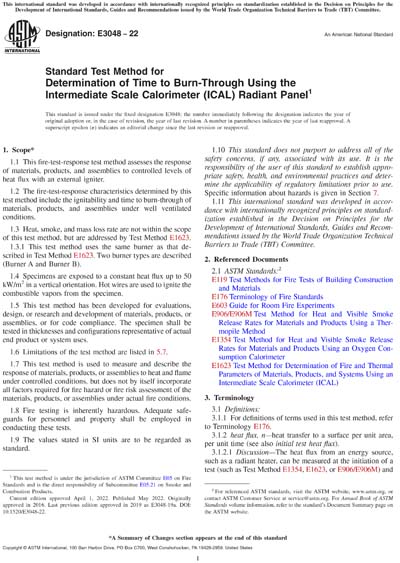Historical
ASTM E3048-22
Standard Test Method for Determination of Time to Burn-Through Using the Intermediate Scale Calorimeter (ICAL) Radiant Panel
1.1This fire-test-response test method assesses the response of materials, products, and assemblies to controlled levels of heat flux with an external igniter.
1.2The fire-test-response characteristics determined by this test method include the ignitability and time to burn-through of materials, products, and assemblies under well ventilated conditions.
1.3Heat, smoke, and mass loss rate are not within the scope of this test method, but are addressed by Test Method E1623.
1.3.1This test method uses the same burner as that described in Test Method E1623. Two burner types are described (Burner A and Burner B).
1.4Specimens are exposed to a constant heat flux up to 50 kW/m2 in a vertical orientation. Hot wires are used to ignite the combustible vapors from the specimen.
1.5This test method has been developed for evaluations, design, or research and development of materials, products, or assemblies, or for code compliance. The specimen shall be tested in thicknesses and configurations representative of actual end product or system uses.
1.6Limitations of the test method are listed in 5.7.
1.7This test method is used to measure and describe the response of materials, products, or assemblies to heat and flame under controlled conditions, but does not by itself incorporate all factors required for fire hazard or fire risk assessment of the materials, products, or assemblies under actual fire conditions.
1.8Fire testing is inherently hazardous. Adequate safeguards for personnel and property shall be employed in conducting these tests.
1.9The values stated in SI units are to be regarded as standard.
1.10This standard does not purport to address all of the safety concerns, if any, associated with its use. It is the responsibility of the user of this standard to establish appropriate safety, health, and environmental practices and determine the applicability of regulatory limitations prior to use. Specific information about hazards is given in Section 7.
1.11This international standard was developed in accordance with internationally recognized principles on standardization established in the Decision on Principles for the Development of International Standards, Guides and Recommendations issued by the World Trade Organization Technical Barriers to Trade (TBT) Committee.
Content Provider
ASTM International [astm]






